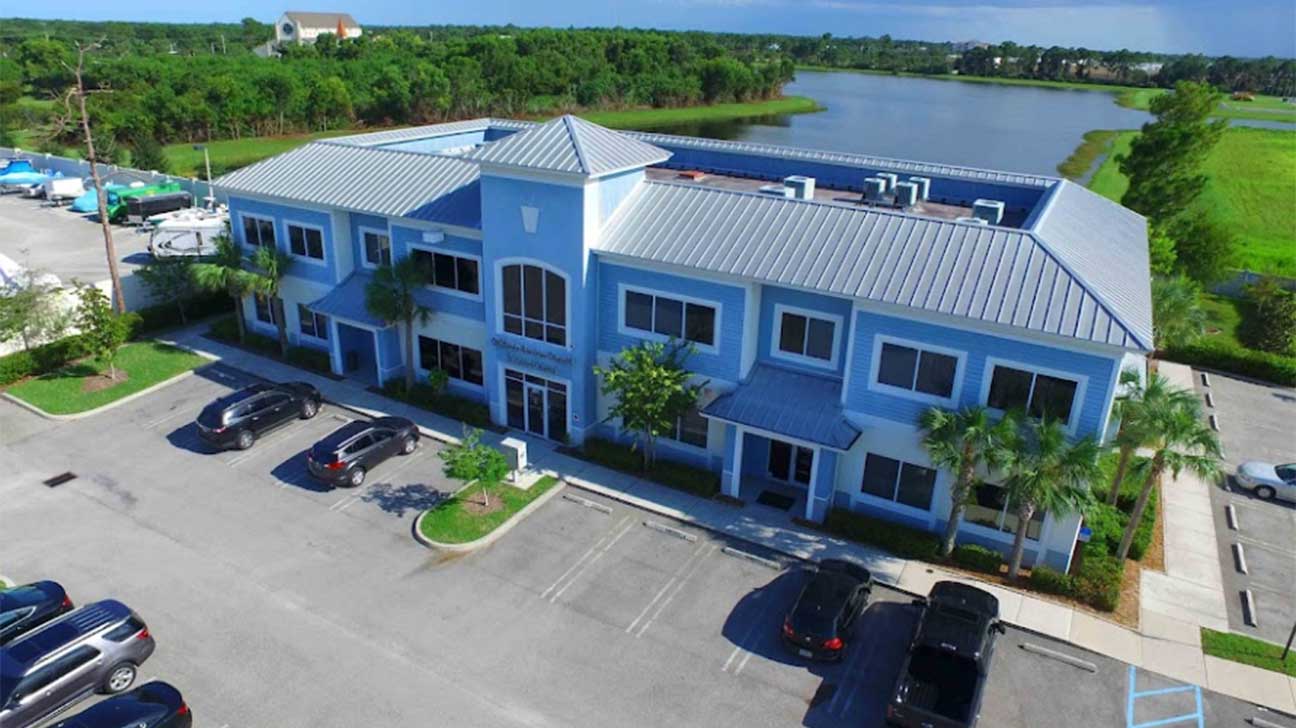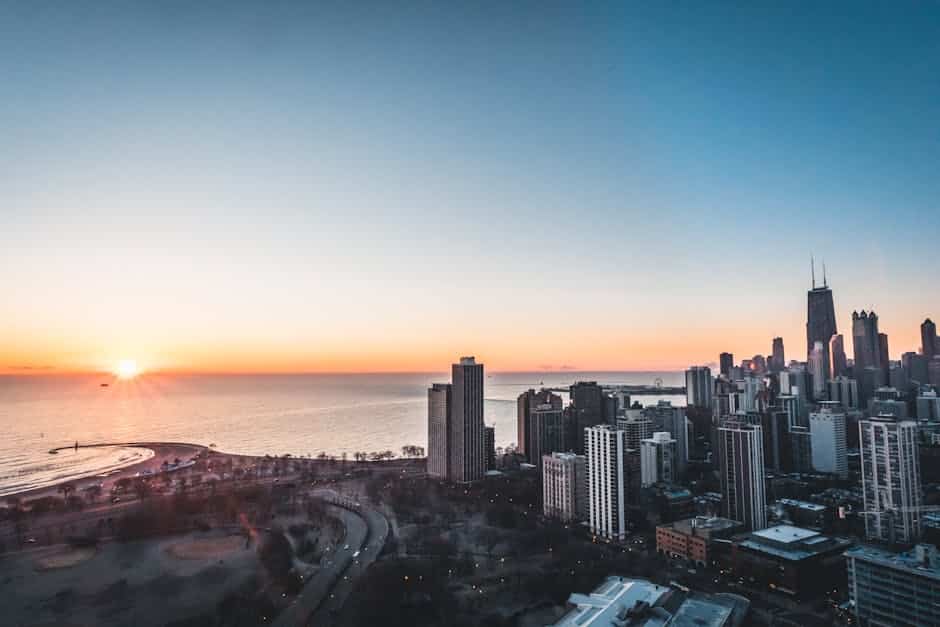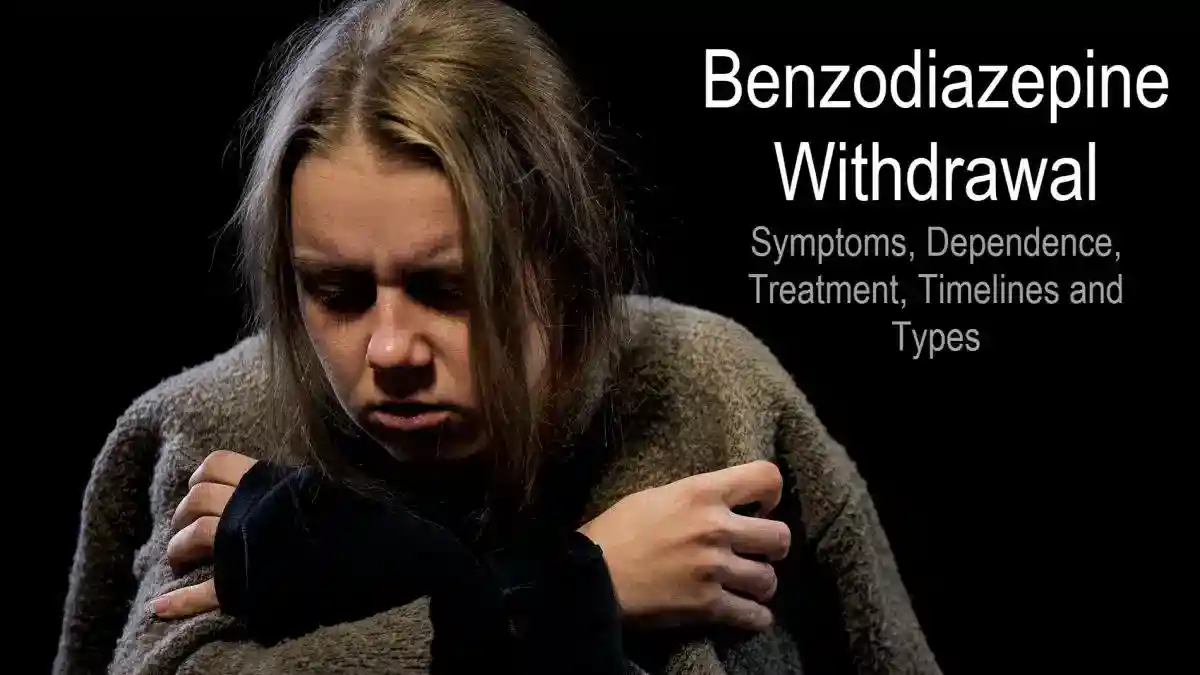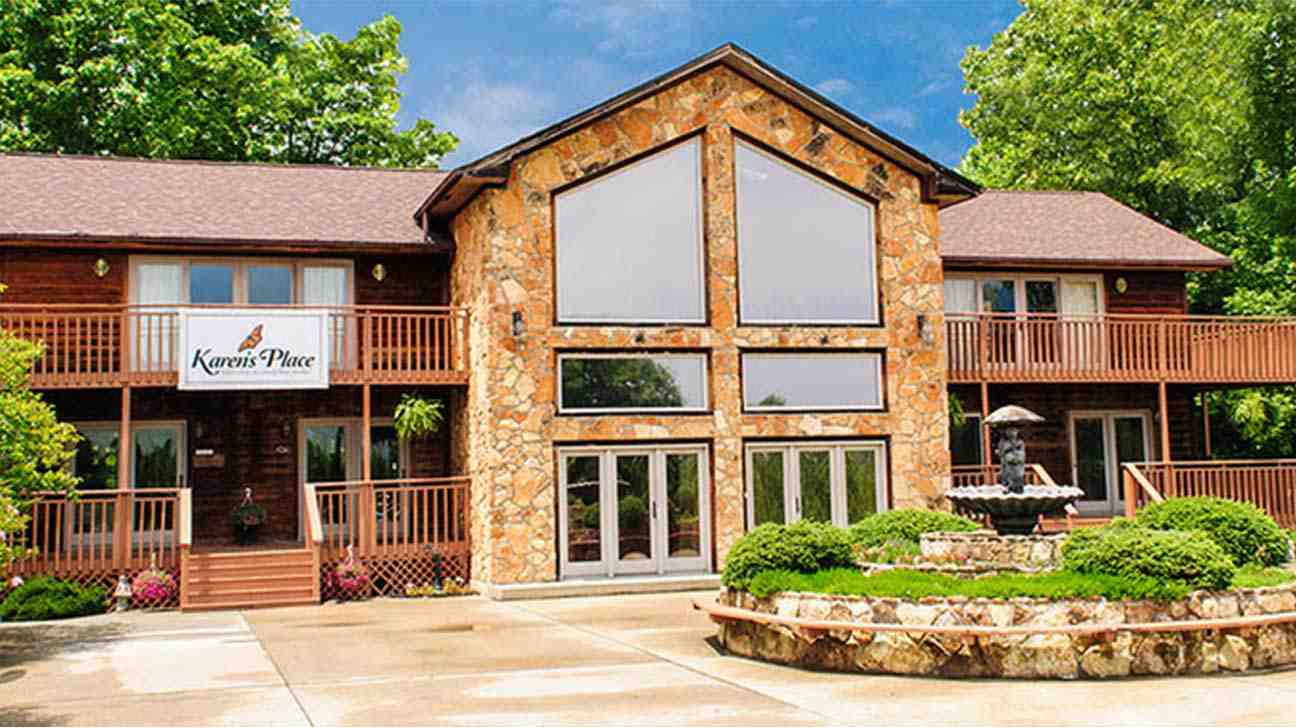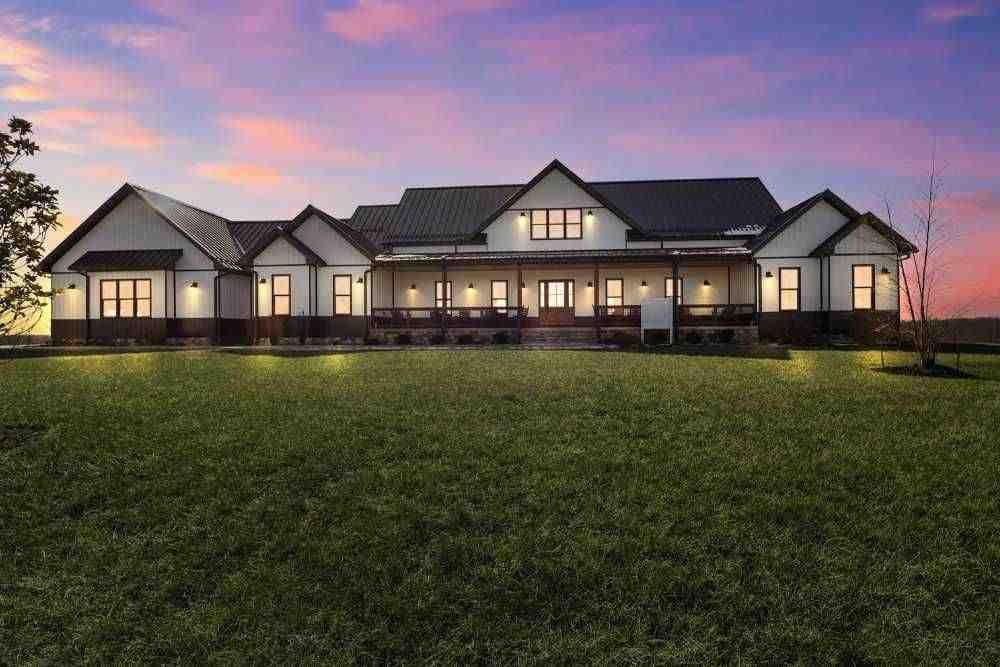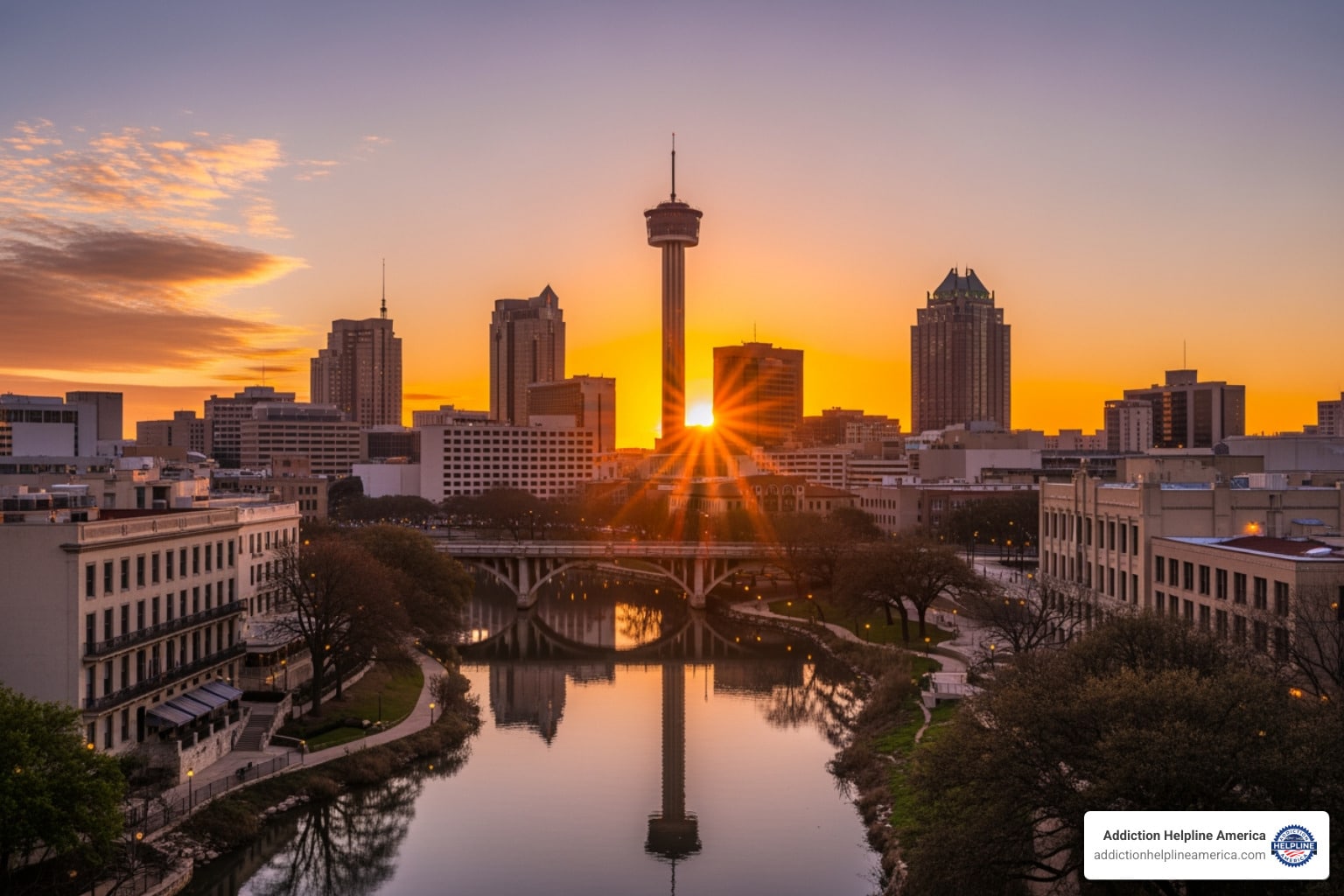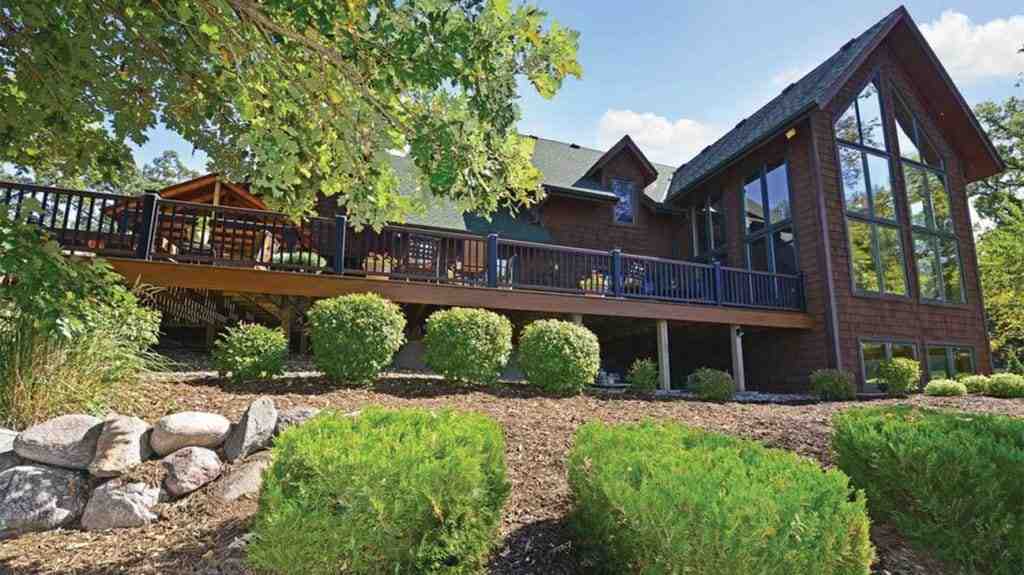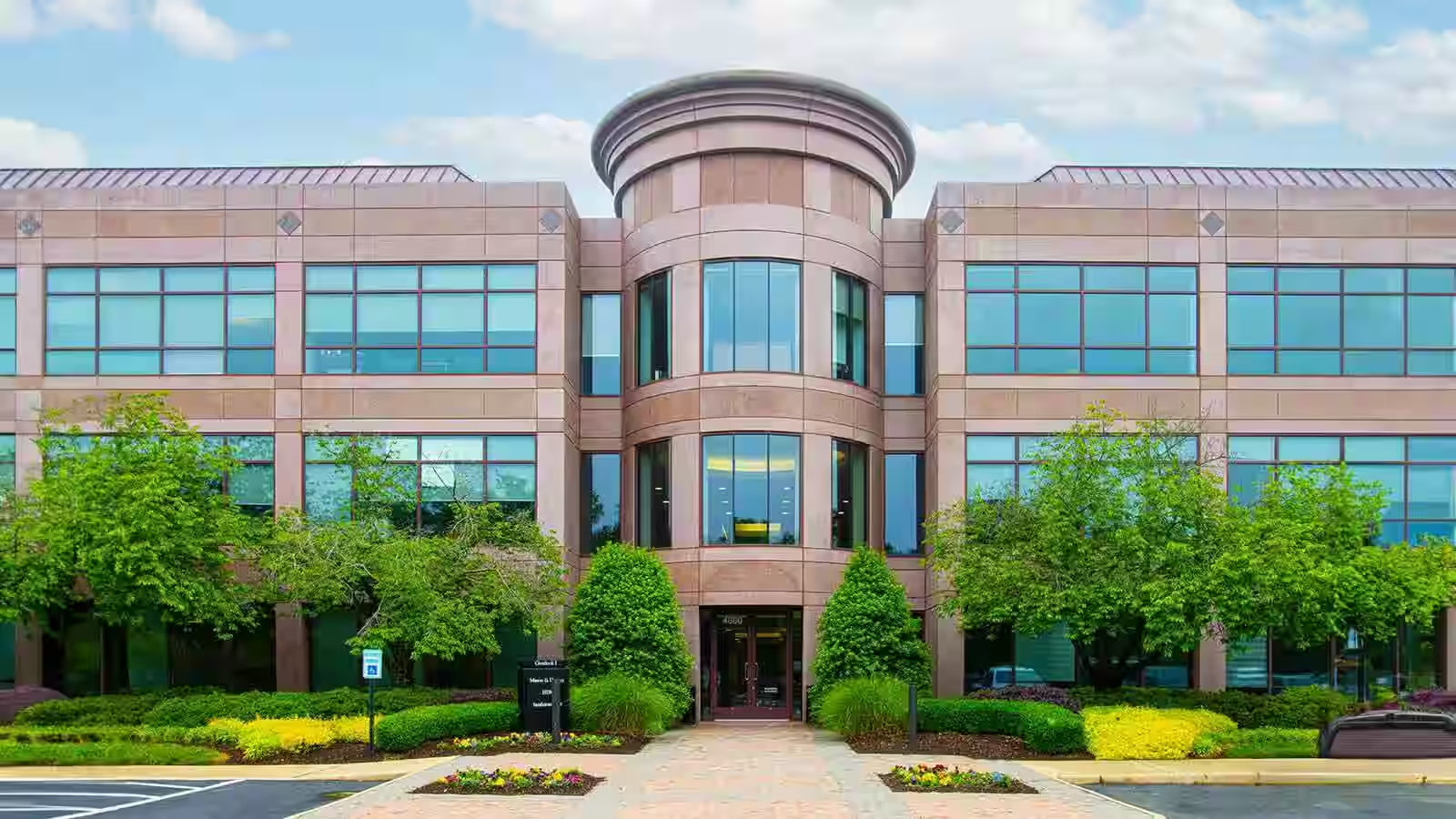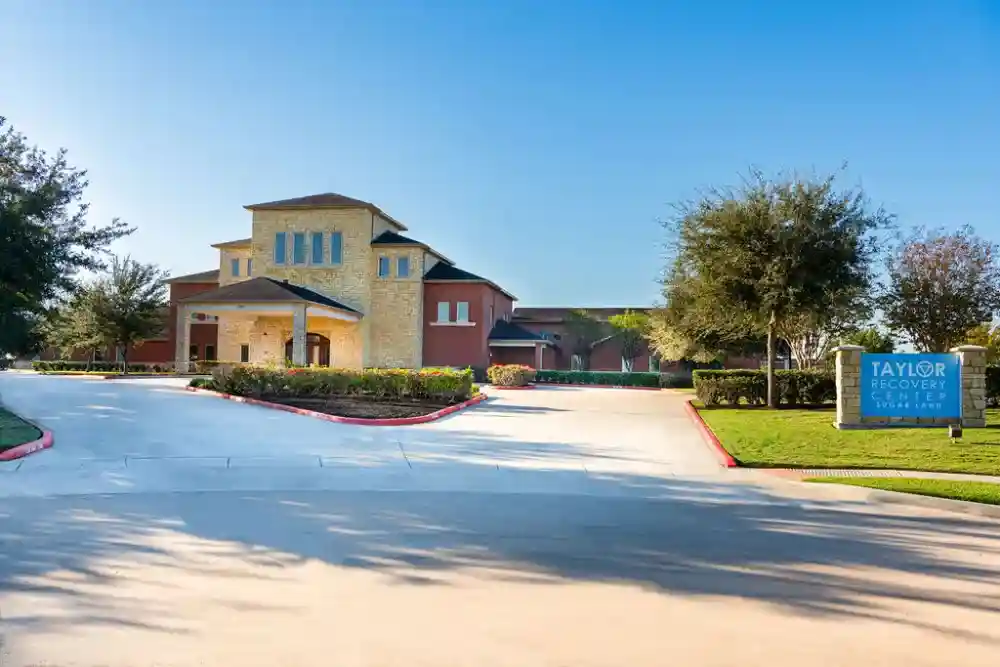
Making Sense Of Holistic Drug Rehab: Beyond Quick Fixes
The term “holistic” can feel a bit fuzzy, but in addiction treatment, it signals a significant change in how we view recovery. Imagine trying to repair a high-performance engine by only changing the oil. It’s a vital step, but it completely ignores the spark plugs, the fuel filter, and the electrical system. Traditional rehab often concentrates heavily on the physical part of addiction—the detoxification process—which is like just changing the oil. A holistic drug rehab program, however, tunes up the entire engine. It works from the idea that true, lasting recovery means healing the mind, body, and spirit as one interconnected system.
This method goes further than just managing the symptoms of substance use. It aims to find and resolve the root causes. Why did addiction develop in the first place? Was it due to unresolved trauma, ongoing stress, a feeling of aimlessness, or other mental health conditions like anxiety or depression? A holistic view recognizes that these issues are not separate from substance dependency but are deeply connected. Treatment, therefore, must be equally integrated, combining proven clinical practices with complementary therapies that support overall well-being.
The Core Components of a Holistic Approach
This combined model doesn’t aim to replace medical science; it enhances it. The objective is to build a recovery foundation strong enough to handle life’s future difficulties. This involves giving individuals a varied set of tools to manage stress, handle emotions, and find meaning without turning to substances.
The following infographic shows the main pillars that form a holistic treatment plan.
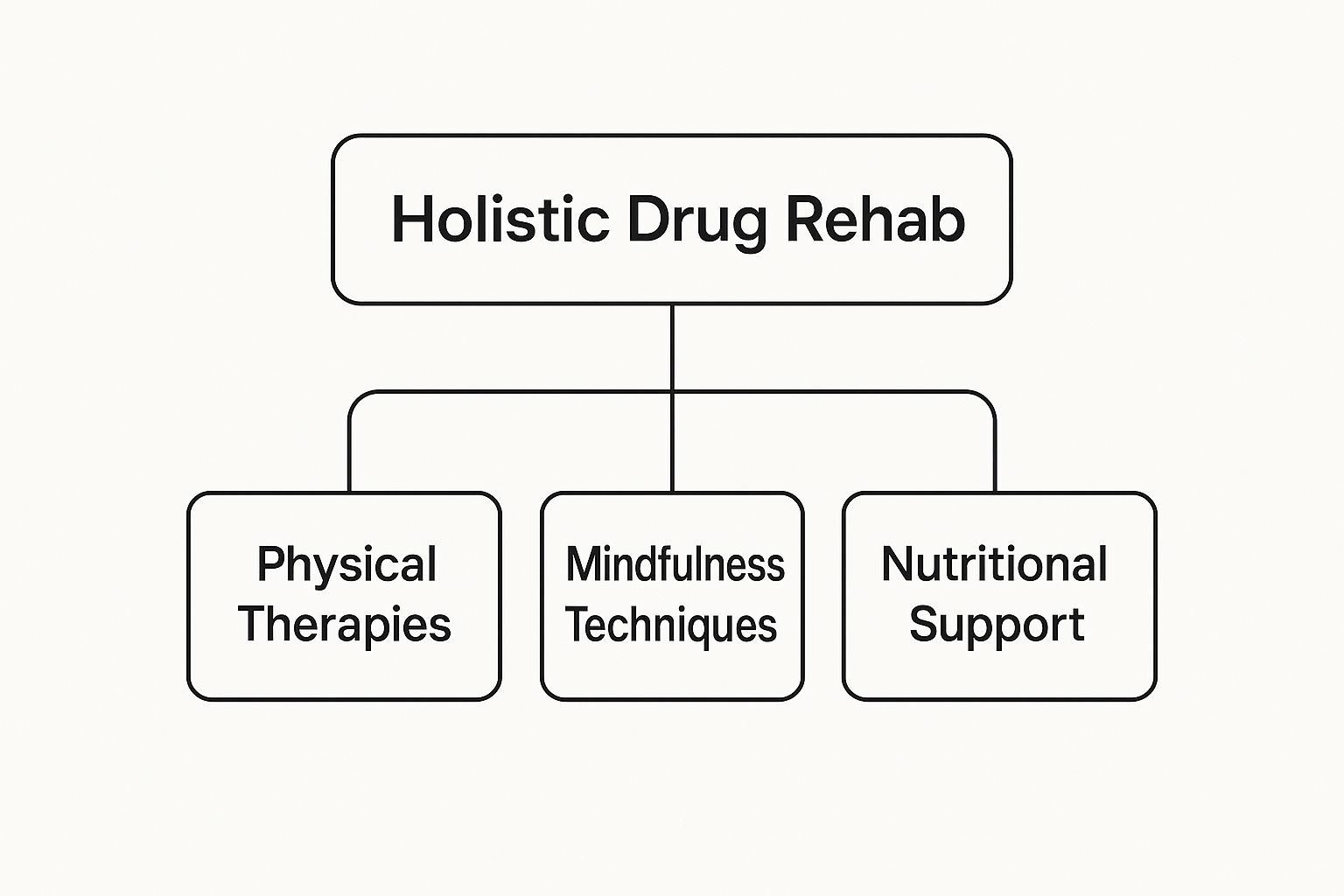
As you can see, a holistic drug rehab program starts with the individual and expands to address different but connected areas of their life and health.
Comparing Treatment Philosophies
To truly see the value of a holistic program, it helps to compare it directly with more conventional methods. Let’s look at a side-by-side comparison.
| Treatment Aspect | Traditional Approach | Holistic Approach | Combined Benefits |
|---|---|---|---|
| Primary Focus | Addresses the physical addiction and resulting behaviors. | Addresses the whole person: mind, body, and spirit. | Creates a more resilient foundation for recovery by treating symptoms and their root causes. |
| Core Methods | Medically-supervised detox, individual and group therapy (e.g., CBT, DBT). | Includes traditional methods plus yoga, meditation, nutrition counseling, and art therapy. | Provides a wider range of coping mechanisms and tools for long-term wellness. |
| Underlying Causes | May address co-occurring disorders but often treats them as separate issues. | Actively seeks to uncover and heal underlying trauma, stress, and spiritual distress. | Leads to deeper self-awareness and helps prevent relapse by resolving core issues. |
| Success Metric | Primarily measured by abstinence from substances. | Measured by abstinence plus improvements in overall quality of life, emotional health, and fulfillment. | Defines success not just as sobriety, but as a thriving, well-rounded life. |
This table shows that while a traditional program establishes a critical foundation, a holistic program adds essential layers of support for the whole person.
This broader approach is becoming more important. The challenge of substance use in the U.S. is significant, with over 21 million Americans needing treatment. The addiction treatment industry is expected to grow past $53 billion by 2025, showing a clear demand for effective, person-centered care. This growth indicates a wider acceptance of models that merge medical detox with counseling, physical wellness, and social support. For a closer look at these trends, you can explore more addiction industry statistics from Growtha.
Recovery is not a one-size-fits-all journey. A holistic framework can be applied across various levels of care, from medical detox to long-term residential programs, to suit individual needs. Ultimately, choosing a holistic drug rehab is a decision to invest in thorough healing, which helps build a stronger and more sustainable path to a substance-free life.
The Treatment Arsenal: What Holistic Recovery Actually Looks Like
When you picture addiction treatment, clinical settings and group therapy often come to mind. While these are vital, a modern holistic drug rehab program offers a much broader set of tools for recovery. Think of it less like receiving a standard set of wrenches and more like building a custom toolkit for lifelong well-being. The goal is to provide a variety of healing experiences so each person can find what truly works for them, creating a personal and effective path forward.
This approach blends evidence-based psychological care with therapies that address the body and spirit. For instance, a day might start with a session of Cognitive Behavioral Therapy (CBT) to reframe destructive thought patterns, followed by an afternoon of equine therapy. Interacting with horses can be a powerful way to build trust and learn emotional regulation, as these perceptive animals often reflect a person’s internal state. This blend of traditional and experiential methods creates a well-rounded and engaging healing process.
Call Now – Your Journey to Recovery Begins Today!

Take the first step towards a healthier life! Call now to connect with our compassionate team and start your recovery journey today. Your path to healing awaits!
Our recovery specialists are available 24/7 to provide support, and all calls are confidential and free. Reach out anytime – we’re here to help!
A Spectrum of Healing Modalities
A key strength of the holistic model is its diversity. It acknowledges that what helps one person process trauma or manage cravings might not resonate with another. By providing different options, these programs empower individuals to discover new strengths and healthy ways to cope.
To give you a clearer picture, this table breaks down some common holistic therapies, explaining their purpose and benefits.
Holistic Treatment Modalities and Their Benefits
Comprehensive overview of various holistic therapies used in drug rehab, their primary focus areas, and expected outcomes
| Treatment Modality | Primary Focus | Key Benefits | Best Suited For |
|---|---|---|---|
| Nutritional Counseling | Rebuilding physical health through diet. | Stabilizes mood, reduces cravings, restores energy levels. | Individuals experiencing physical depletion from substance use. |
| Yoga & Meditation | Connecting mind and body; developing mindfulness. | Lowers stress, increases self-awareness, improves emotional regulation. | Anyone needing tools to manage anxiety and impulsivity. |
| Art & Music Therapy | Non-verbal expression of complex emotions. | Processes trauma, boosts self-esteem, provides a healthy creative outlet. | Those who struggle to verbalize their feelings or have a creative inclination. |
| Adventure Therapy | Building confidence through physical challenges. | Fosters teamwork, develops problem-solving skills, teaches healthy risk-taking. | Individuals looking to build self-reliance and step outside their comfort zone. |
This table shows that each therapy serves a specific function, from rebuilding the body with proper nutrition to healing emotional wounds through creative expression.
Finding the Right Combination of Therapies
This variety ensures treatment feels personal and relevant. Someone who finds it hard to talk about past events might have a breakthrough while painting in art therapy. Another person may build newfound confidence after finishing a challenging hike during adventure therapy. The important thing is that these are not just bonus activities; they are thoughtfully integrated parts of a clinical plan, led by trained professionals. You can learn more about how these different approaches are combined by exploring the main types of addiction therapy used in treatment today.
For those ready to find a program, there are resources to help you locate facilities that offer these specific services. For example, the SAMHSA Find Treatment tool lets you filter your search for centers providing specialized care.

As shown in the screenshot, you can adjust your search to find a treatment center that matches your specific recovery needs. In the end, the power of a holistic drug rehab program is its flexibility and its dedication to treating every part of a person. It is about building a rich, meaningful life where substances no longer have a place.
The Brain Science Behind Whole-Person Healing
Addiction isn’t just a habit; it physically reshapes the brain by creating powerful neural pathways. Imagine a river that has carved a deep canyon over many years. The water, representing substance use, naturally flows down this well-worn path. A **holistic drug rehab** program works to not only stop the flow but to help the brain chart new, healthier riverbeds.
This remarkable ability of the brain to reorganize itself by forming new connections is called neuroplasticity. Holistic therapies are particularly effective because they encourage this rewiring process from several angles at once, helping to create stronger and more permanent changes.
For example, mindfulness meditation, a common practice in holistic treatment, has been shown to increase gray matter in the prefrontal cortex. This is your brain’s “CEO,” in charge of decision-making, impulse control, and managing emotions—all functions that addiction can weaken. Likewise, activities like yoga or hiking release endorphins and dopamine, giving you a natural mood boost and helping to reset the brain’s reward system that drugs have hijacked.
Building a Healthier Brain Chemistry
What you eat also plays a vital part in this neurological healing. A diet packed with the right nutrients is crucial for producing neurotransmitters like serotonin and dopamine, which are essential for mood stability and keeping cravings at bay. When these chemicals are in short supply, it can lead to feelings of depression and anxiety, making the pull of substance use much stronger.
This approach also recognizes the deep link between the mind and body. Many holistic programs include therapies designed to release trauma that gets stored physically. Practices such as therapeutic massage, yoga, or Qigong can help process these stored emotional pains, which often show up as physical tension and fuel the cycle of addiction. By calming the nervous system, these therapies address the underlying reasons for substance use.
The medical community is increasingly recognizing the power of these methods. The global market for addiction rehab facilities was valued at approximately $19.02 billion in 2024 and is expected to grow. This trend shows a clear shift toward treatment models that focus on healing the entire person. For more details on this industry trend, you can explore the full addiction rehab market research.
The Scientific Foundation of Treatment
The success of these therapies is supported by extensive scientific research into how addiction impacts the brain. The National Institute on Drug Abuse (NIDA) is a leading force in this field, funding studies that guide modern recovery practices.
This screenshot from NIDA’s website shows the different areas of research that shape effective treatment today.
The image highlights that a successful recovery plan is composed of many parts. It combines behavioral therapies, appropriate medications, and support for co-occurring mental health conditions—all key elements of a quality holistic drug rehab program. Achieving lasting sobriety is not about willpower alone; it’s about systematically rebuilding the brain with proven strategies and consistent support.
Your Day-By-Day Recovery Experience: What Actually Happens
Stepping into a holistic drug rehab program can feel like walking into a new and unfamiliar world. It’s natural to have questions or feel anxious about what your days will look like. However, the structured environment you’re about to enter is designed to be a source of stability and comfort, not stress. This routine creates a predictable and supportive space, allowing you to direct all your energy toward healing.
Think of your day starting with purpose instead of chaos. Many programs provide optional morning activities like guided meditation or gentle yoga to help you center your mind. This is followed by a nutritious breakfast, often designed by a nutritionist to help stabilize blood sugar, repair your body, and boost your mood. This focus on physical well-being is a core part of the holistic approach, building a strong foundation for the mental and emotional work ahead.
A Typical Day in Holistic Treatment
Mornings are generally reserved for focused therapeutic work. This is when you’ll likely have one-on-one sessions with a therapist who understands the deep connections between addiction, trauma, and mental health. These private meetings are a safe space for you to work through personal challenges and build new coping skills.
Afternoons often shift toward group activities and experiential therapies. Your schedule might include a mix of the following:
- Group Therapy: Sharing your story with peers who truly understand what you’re going through helps build connections and combats feelings of isolation.
- Physical Activity: This could be anything from a guided hike to a group yoga class. The goal is to reconnect with your body in a positive way and naturally improve your mood.
- Creative Expression: Art, music, or writing therapy can be powerful tools for processing emotions that are hard to put into words.
Evenings are for winding down and integrating the lessons of the day. This time might feature workshops on practical life skills, such as financial management or developing healthier communication patterns. Family therapy, often held through video calls, can also be part of the evening schedule, helping to repair relationships and create a solid support system for when you return home. The day typically concludes with time for personal reflection, giving you a quiet moment to process your thoughts and progress.
Call Now – Your Journey to Recovery Begins Today!

Take the first step towards a healthier life! Call now to connect with our compassionate team and start your recovery journey today. Your path to healing awaits!
Our recovery specialists are available 24/7 to provide support, and all calls are confidential and free. Reach out anytime – we’re here to help!
Finding the Right Program for Your Journey
The first step on your recovery path is finding a treatment center that fits your personal needs. Fortunately, there are resources designed to make this search easier.
The screenshot below, from the official FindTreatment.gov website, shows how you can use their simple tool to locate facilities in your area.
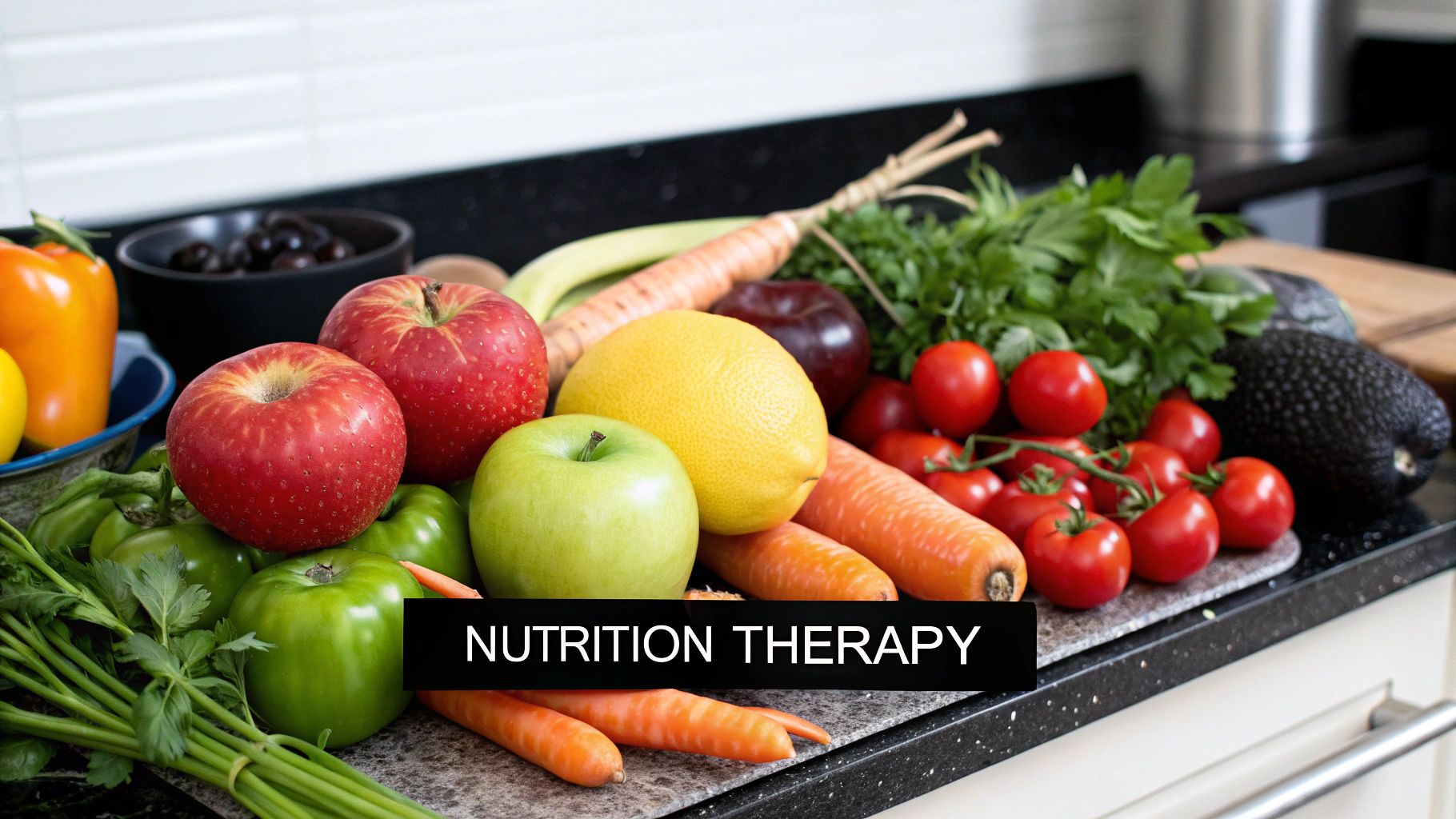
This tool allows you to filter your search by location, making it easier to find accessible support. As you move from detox to residential care and then to outpatient services, your treatment plan will change with you. A quality holistic drug rehab program will regularly adjust your schedule and therapies based on your progress, making sure your experience is always relevant and helpful. This personalized, day-by-day method is designed to help you rebuild not just your sobriety, but your entire life.
Finding Your Perfect Treatment Match: Specialized Programs
Not every holistic drug rehab program is built the same. Achieving lasting recovery often comes down to finding a genuine connection between your personal story and a program’s particular focus. Think of it like a doctor prescribing a specific medicine for a specific illness—the most effective treatment plans are carefully chosen for the individual. This personalized care is a foundation of the holistic model, which acknowledges that our life experiences shape both addiction and the path to healing.
The demand for specialized care is growing. The global addiction treatment market was valued at nearly $9.44 billion in 2024 and is expected to continue expanding. In North America alone, the market exceeds $3.49 billion, which helps fund the creation of more diverse and focused programs. You can find more details about this trend by exploring the detailed addiction treatment market analysis on Precedence Research.
Finding a Program That Understands You
Specialization allows treatment to move beyond sobriety alone and address the specific life circumstances that fuel substance use. This approach helps ensure that the therapy, environment, and even the other people in your group are relevant to your situation, creating a more powerful healing journey.
- Gender-Specific Programs: Programs for women often provide a supportive setting to work through issues like trauma, body image, and the demands of parenting. Men’s programs might concentrate on handling work-related stress, societal expectations of masculinity, and constructive ways to manage anger.
- Age-Specific Tracks: A young adult’s recovery needs are very different from those of an older adult. Programs for younger people may include career counseling and guidance on navigating social media. In contrast, tracks for older adults might address challenges related to retirement or managing chronic health conditions.
- Profession-Focused Treatment: People in high-stress jobs face unique hurdles. There are specialized programs for professionals like healthcare workers, executives, and first responders that address job pressures and licensing issues in a completely confidential environment.
- Substance-Specific Care: Different drugs require different recovery strategies. Opioid treatment programs frequently incorporate medication-assisted treatment (MAT), while alcohol-focused programs may spend more time on navigating social situations where drinking is common. For those looking for support in a state with numerous facilities, you might find our guide on finding effective rehab in California for addiction treatment helpful.
Using Resources to Narrow Your Search
With so many options, finding the right fit can feel like a huge task. Thankfully, there are tools available to help you sort through the choices. Online directories are specifically designed to help you find programs that meet your exact needs.
For instance, Psychology Today’s directory allows you to filter your search by issues, age, gender, and more to find the best match.
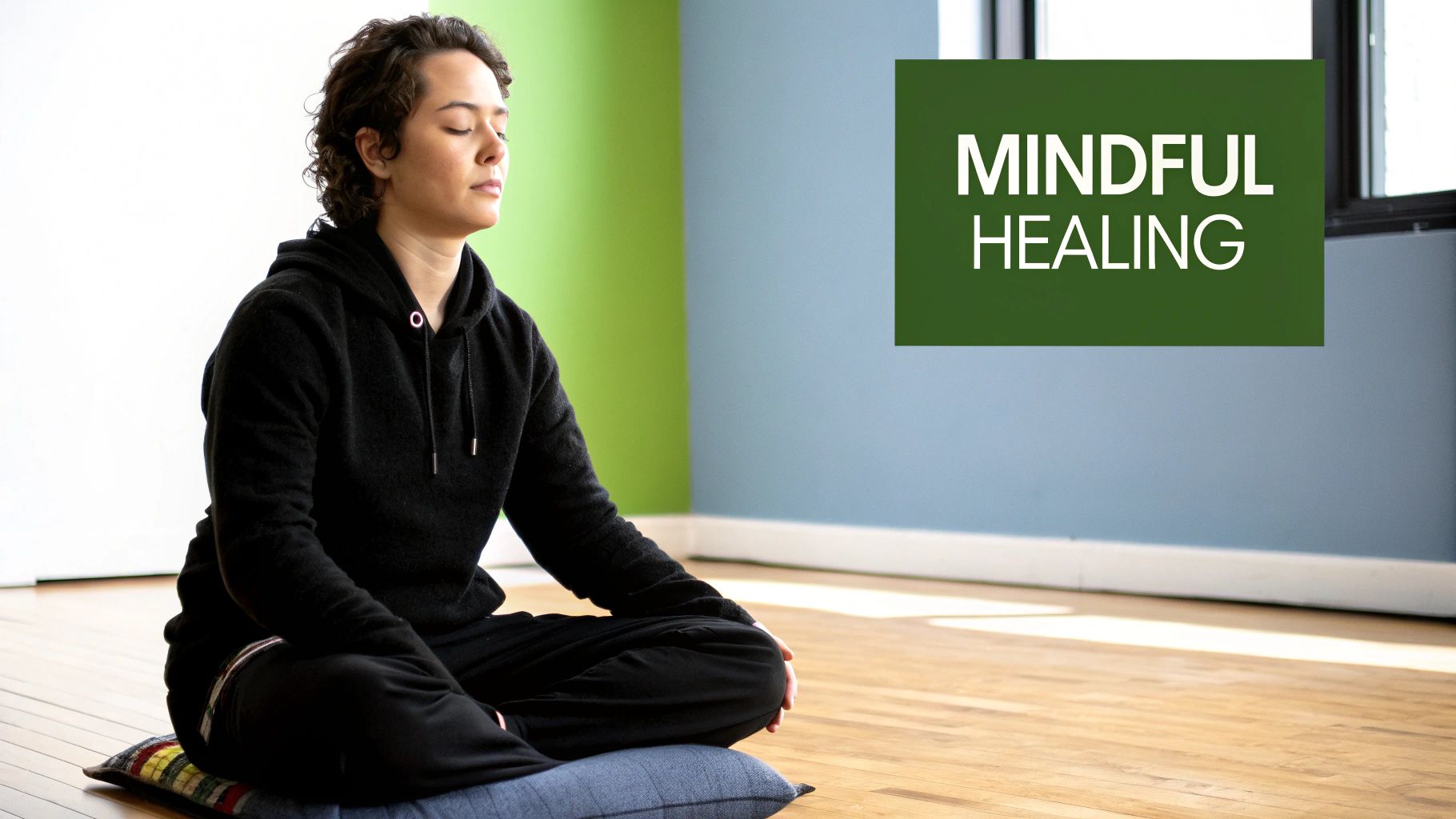
This screenshot demonstrates how you can use detailed filters to locate a holistic drug rehab center that offers the specific type of care you’re looking for. Ultimately, investing time to find the right program is the first major step toward building a successful and sustainable recovery.
Choosing Your Program: The Real Selection Process
Picking the right holistic drug rehab program is one of the most critical decisions you’ll ever make. This choice deserves more thought than buying a car or a house because it directly shapes your future. To make the best decision, you have to become an informed consumer, asking sharp questions that go far beyond what you see in a glossy brochure. First, look into the program’s core philosophy. Is their holistic approach truly integrated into their clinical model, or are things like yoga and art therapy just optional add-ons?
The quality of care you receive comes down to the people who provide it. You should feel comfortable asking about the staff’s credentials, licenses, and specific training in holistic methods. A trustworthy center will be open about how they measure success, using metrics that go beyond just counting days of sobriety. It is also essential to know how they handle medical needs, particularly during detox. A genuine holistic program supports, but never tries to replace, crucial medical supervision. Be cautious of any facility that makes unrealistic promises, discourages your family from being involved, or insists they have a single solution for everyone; these are serious red flags.
Navigating Insurance and Costs
One of the most common obstacles is figuring out what your insurance will cover. Traditional methods like cognitive-behavioral therapy are usually included, but many complementary treatments might not be. This financial uncertainty can add a lot of stress when your focus should be on getting well.
The best way to get answers is to be direct. Call your insurance company and ask specific questions about coverage for “out-of-network” residential facilities and specific therapies like acupuncture or nutritional counseling. Many rehab centers have admissions staff who are experienced in this area and can help you navigate the process, sometimes even speaking to the insurance company for you.
Online resources can also give you a preliminary idea of your benefits. The image below shows a typical insurance verification form, which is often the first step.
Using tools like this helps you get a quick estimate of your coverage and what you might have to pay yourself, providing a clearer financial outlook.
Evidence-Based Treatment vs. Luxury Retreats
It’s vital to tell the difference between a real, evidence-based holistic drug rehab and a luxury retreat that focuses more on spa-like perks. While a comfortable setting is nice, the main objective is always measurable, lasting healing. A quality program is centered on clinical results and giving you practical skills for life after you leave. You can bring your family into this decision-making process for support, but the final choice must be based on your individual needs and what feels right for your healing journey. Using a confidential resource like the Addiction Helpline America can offer expert advice, helping you review programs and find a center that truly matches your goals for a healthy, substance-free life.
Call Now – Your Journey to Recovery Begins Today!

Take the first step towards a healthier life! Call now to connect with our compassionate team and start your recovery journey today. Your path to healing awaits!
Our recovery specialists are available 24/7 to provide support, and all calls are confidential and free. Reach out anytime – we’re here to help!
Building Your Recovery Life: Beyond Treatment Walls
The true test of a holistic drug rehab program isn’t just about how you feel when you complete it; it’s about how you navigate life six months, one year, and even five years later. Moving back into the rhythm of daily life—with its responsibilities, relationships, and unexpected pressures—is where your new recovery skills are truly challenged. The techniques learned in treatment shift from being abstract ideas to essential, practical tools for building a new foundation. This is the stage where lasting change happens, turning sobriety from a daily goal into a sustainable way of living.
Think of your time in treatment as learning to use a new set of high-quality tools in a perfectly organized workshop. Now, you’re stepping out to build your life in the real world with those same tools. A morning meditation is no longer just a peaceful exercise; it’s the anchor that stabilizes your day before challenges arise. Regular exercise becomes your reliable method for managing stress and lifting your spirits, while ongoing therapy sessions act as scheduled maintenance checks to help you process life’s hurdles.
Integrating Holistic Practices into Daily Life
Weaving these new practices into your daily routine is a gradual process. Trying to implement everything all at once can feel overwhelming and quickly lead to burnout. Instead, begin with small, manageable steps. This might mean committing to a ten-minute walk each day or attending one support group a week. As your confidence grows, you can slowly incorporate more practices. The objective is to build a supportive structure that enhances your well-being without becoming a source of stress itself.
It’s also vital to adapt your recovery plan as your life evolves. A strategy that was effective when you were unemployed may need adjustments when you start a demanding new job. Handling conflicts in relationships or family crises will require you to lean on your support network and use the emotional regulation techniques you’ve developed. The importance of aftercare in addiction is immense; it offers the continued structure needed to navigate these real-world tests successfully.
Sustaining Long-Term Wellness
Maintaining a holistic lifestyle is about far more than just preventing relapse; it’s about continuing your personal growth. This involves consistently managing any co-occurring mental health conditions and actively creating a life that supports your sobriety. The Substance Abuse and Mental Health Services Administration (SAMHSA) defines recovery as a process of change through which individuals improve their health and wellness.
The screenshot below from SAMHSA outlines the four critical dimensions that support a life in recovery.
This image shows that a strong recovery is built on Health, Home, Purpose, and Community—all central elements that a quality holistic drug rehab program helps you cultivate. Graduates who find long-term success are those who actively build careers and relationships that reinforce their commitment to treating their whole self.
If you are building your recovery life and need guidance, support is always available. Contact Addiction Helpline America at any time to connect with specialists who can help you strengthen your journey beyond the walls of treatment.
Our helpline is 100%
free & confidential
If you or someone you care about is struggling with drug or alcohol addiction, we can help you explore your recovery options. Don’t face this challenge alone—seek support from us.
Programs
Resources
Will my insurance
cover addiction
treatment?
We're ready to help
Find the best
drug or alcohol treatment
center
Are you or a loved one struggling with addiction? Call today to speak to a treatment expert.





